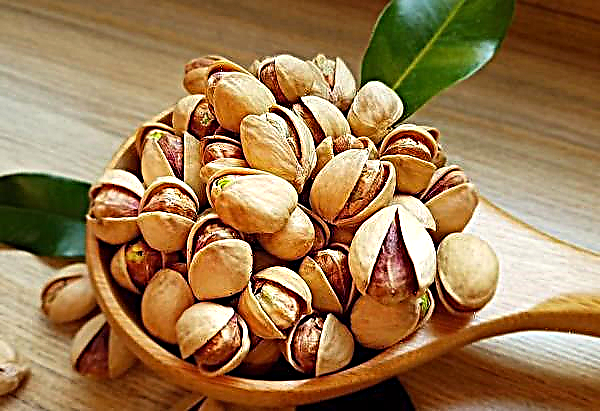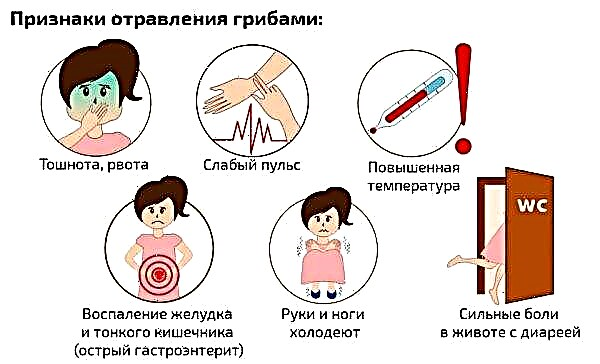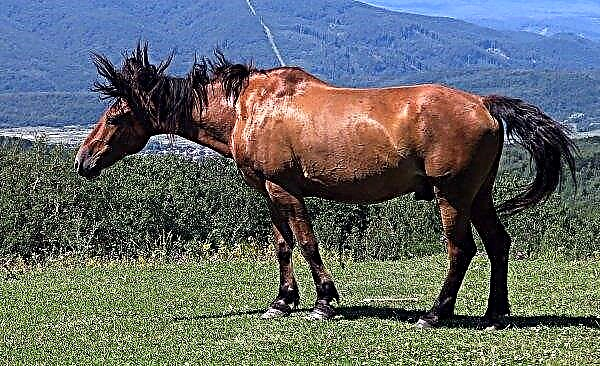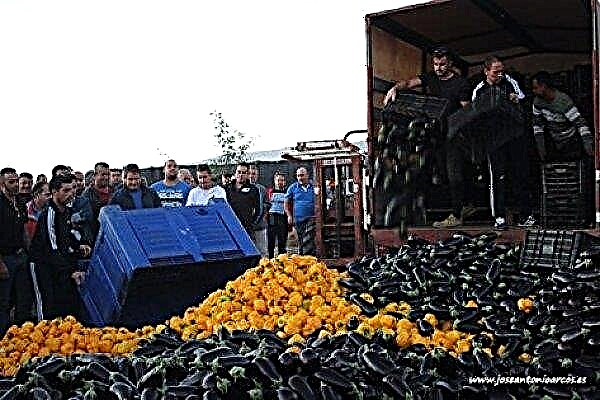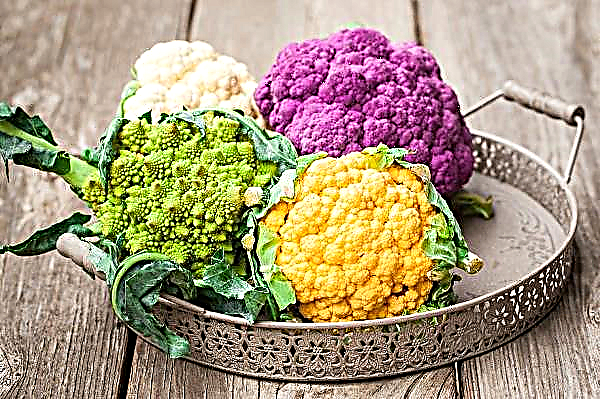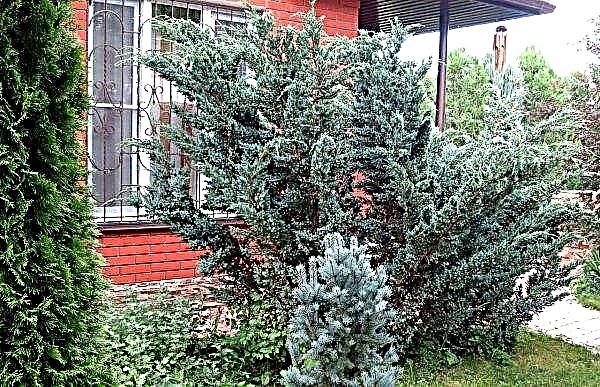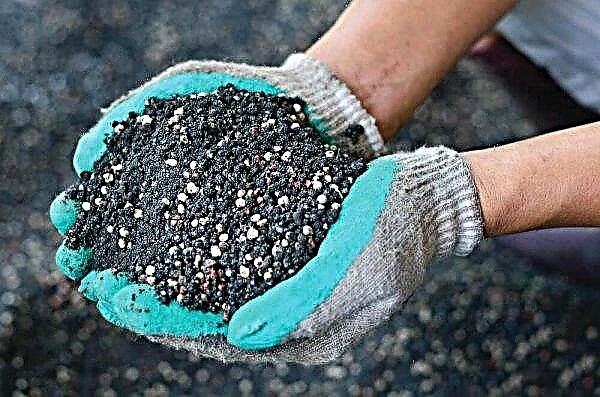When growing carrots, rarely has anyone come across a manifestation of a particular disease that can affect a vegetable. The most common plant diseases can and must be fought in order to obtain a guaranteed crop. The article contains information on carrot diseases and methods for their treatment and prevention.
The main diseases of carrots: their description and methods of treatment
Below are the most common lesions of carrot plantings.
White rot (sclerotinia)
This putrid root disease occurs due to the spread of Sclerotinia sclerotiorum (Lib.), A fungus that causes white rot. At the first stage, wound surfaces are formed on vegetables, in which the rapid development of the fungus occurs. In a short period of time, the mycelium affects the entire fetus, manifesting in white and black seals, which are the source of mushroom sclera. They are viable in air and soil for a long period of time.
Of particular danger is the above fungal infection in vegetable stores, as it leads to the rapid spread of the disease of nearby vegetables.
Before laying for storage, carrots are disinfected with TMTD fungicide, in concentrations, according to the annotation to the preparation, and also dusted with chalk dust.
Important! Mushroom spores die when seeding siderates (vetch, soy, mustard, rapeseed, etc.) on soil affected by felt rot.
Felt rot (rhizoctonia)
Disease caused by fungal infection - rhizoctonia. Active development of the disease occurs when crop rotation is not observed (mono-planting in one place), since the mushroom tends to accumulate in the soil. The source of infection are also boxes that have not passed the timely decontamination process, in which carrots are stored. Therefore, as containers for long-term storage, it is recommended to use bags made of dense polyethylene.
The disease manifests itself in the form of small ulcers on the skin, which are covered with white coating.

Wet rot (bacteriosis)
The disease that phytopathogenic bacteria provoke is characterized by a manifestationon the surface of vegetables in wet, rounded areas. High temperatures (+5 ... + 30 ° С) violate the integrity of the ends of root crops (broken off, cut ends) aggravate the development of bacteriosis.
In the basement, infected vegetables completely rot in a short period of time, infecting nearby root crops with wet rot.
Measures to combat bacteriosis include:- timely harvest;
- disinfection of the storage with a sulfur block before laying root crops for storage;
- compliance with the temperature regime during the entire storage period.

Gray or black rot (botridiosis)
This type of rot predisposes not only carrots, but also tomatoes, cucumbers, cabbage, beets, radishes and other vegetables.
Botridiosis develops both during active vegetation and during storage. It is characterized by the manifestation of irregularly shaped spots of a dirty brown shade, followed by the manifestation of greenish mold on them. In the high-risk zone - vegetables harvested late, with signs of hypothermia.
The high storage temperature contributes to the rapid growth of rot rot.You can deal with gray rot by applying a solution of copper sulfate (30 g of chemical per 10 liters of water) into the soil after the harvest is completed. Particularly effective in the processing of soil was the drug “KhOM” - 1 liter of solution (2 g of the drug per liter of water) per hundred square meters.
Timely disinfection, lime cellars whitewashing, observance of crop rotation rules are measures by which observance can be avoided botridiosis.
Dry or brown rot (phomosis)
Phomosis is caused by the fungus Phoma rostrupii Sacc., In which all parts of the plants are affected.
In the second half of summer, the disease is manifested by the appearance on the green parts of plants of whitish spots-stripes, which turn into brown with black specks. Further, the infection spreads to the root crop, which at the cut differs in a brown, dry structure. The surface of the vegetable is covered with gray-brown spots.
During storage, the rotten tissue completely disintegrates, forming voids that are filled with white mycelium.In the fight against the disease, strict observance of the rules of agricultural technology, the alternation of crops on the site, the implementation of the regime of subsequent storage will help. Before sowing, the ridges are shed with the fertilizer “Agricola 5”.
When the active phase of growth of the terrestrial part of plants sets in, spray with the HOM preparation.

Black rot (alternariosis)
Alternariosis is caused by the pathogenic fungus A. Radicina, the active development of which is caused by excessive evening watering of vegetable ridges, while both hot and humid weather. The disease can cause the loss of a third of the total crop.
Root crops cease to grow, curvature appears. The quality of the pulp decreases, due to a decrease in the level of sugar content and carotene. Pathogenic flora persists for a long time in seeds and tops.
The symptoms of the disease during storage are similar to white rot, and at the time of vegetation - with cercosporosis. It is necessary to combat black rot with the help of the fungicidal preparations Prozaro and Falcon.
Brown spotting
The disease provoked by the fungus A. Dauci, manifests itself in fragility and brown color of tops, quickly spreads over the entire area of planting. Gradually, the disease affects the rhizomes, and carrots begin to rot in the ground. Such fruits are not stored.
The biological activity of A. Dauci is very high, therefore, it is recommended to burn the remains of plants after harvesting, since the fungus remains highly pathogenic after decaying of all parts of the carrots.
To protect the future crop from this disease as much as possible, before planting, the carrot seeds are steamed for 10 minutes in hot water, and then placed in a cool water until it cools completely.Important! In order to prevent the disease, in rainy summer it is necessary to constantly loosen the aisle. This will allow the soil to dry faster.
At the first manifestations of the disease, the plants are sprayed with Epin-Extra, Evin or Immunocytophyte.

Root deformation
The following causes of such a pathology are distinguished:
- Carrots lose their presentation due to excessive introduction of fresh manure into the soil, which leads to an overabundance of nitrogenous compounds that cause ugly changes in the root crop, cracking of the root surface. Such vegetables are not suitable for storage.
- Thickened landings. If seedlings are not thinned out, root crops are intertwined, due to lack of space, the fruits are deformed. Such carrots are suitable for animal feed.
- Loose soil is important for carrots. If the ridge was not dug deep enough, carrots in the hard layers of the soil are deformed.
- Soil infestation with nematode peststhat feed on the pulp of a vegetable. From this, the root crop is deformed or dies. With large-scale infection with this pest, the site becomes unusable.
Did you know? You can fight with nematodes with the help of flowers! Pest insects die when the infected ridge is seeded with tagetes (marigolds, black-browed). The following year, the land can be used for growing vegetables.
Powdery mildew
Fungal disease is a real scourge of gardens. Not only vegetable crops, but also currant bushes suffer from it.
The disease appears as yellow spots on the green parts of the plants. Within a week, the damage is so vast that the leaf part of the plants dies. Root crops, in contrast to the leafy part, continue to grow, but acquire signs of deformity and deformation. Powdery mildew is fatal to seeds.
The disease is exacerbated by excessive watering of plants, high humidity.
As a preventive measure, preventive treatments with fungicides are recommended, the first of which is carried out 14 days after germination. Affected plants are dusted with wood ash, which gives a good result. Chemical treatment of plantings should be carried out twice with a weekly break.
In the case when therapeutic measures did not give positive results, all parts of the plant, including the testes, must be burned.
Cercosporosis
A fungal disease caused by Cercospora carotae, and progresses rapidly in conditions of high humidity (rainy periods, wetlands). In the middle of summer, the tops are covered with small spots of rust color, the leaves become "curly" and after a while, fall off. The underground part of the vegetable stops growth and development.
In the fight against cercosporosis apply:
- "Bravo";
- "Gliocladin";
- "Quadrice";
- "Immunocytophyte";
- Trichodermin.
They recommend deep plowing of the site, in which there is a complete turning over of the soil layer, burning of the affected plants.
Did you know? In the XVII century, English aristocrats decorated the fields of their hats with carrot tops, since it retained freshness for a long time, smelled pleasantly and had a presentable appearance.
Preventive actions
There are preventive measures that will help to avoid diseases or minimize the damage caused by pathogenic microorganisms and fungi:
- Before laying carrots for storage, disinfect, whitewash the walls of the store. Provide stable ventilation.
- Root crops are harvested in dry weather, the tops are cut off.
- Storage containers must also be decontaminated. Optimal storage in open plastic bags.
- It is necessary to regularly check root vegetables for spoilage and to remove in due time non-condition from the total volume of vegetables.
- Several times during the winter, you need to look at the bookmark of carrots. Rotten root crops are removed. The degree of preservation of the carrot crop depends on how carefully the grower fulfills all the recommendations and the rules for its cultivation and storage. Following these simple rules, you can save carrots without loss.

Unfortunately, in the process of growing carrots, very often you have to deal with various diseases, the invasion of insect pests such as nematodes, aphids, carrot flies, which can cause serious damage to the future crop. However, observing the techniques of agricultural technology for growing root crops, you can significantly reduce the risk of diseases and get a decent harvest.




